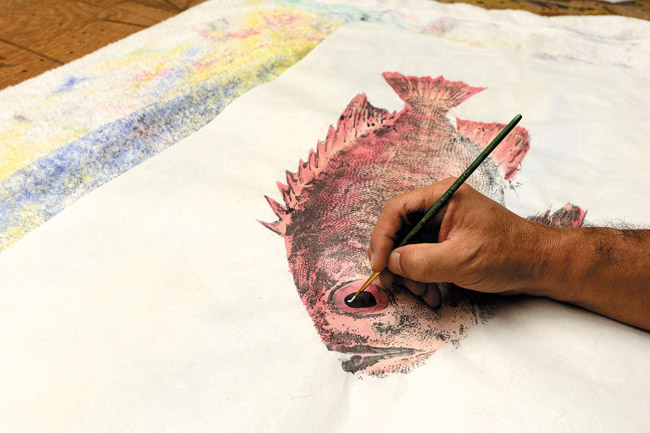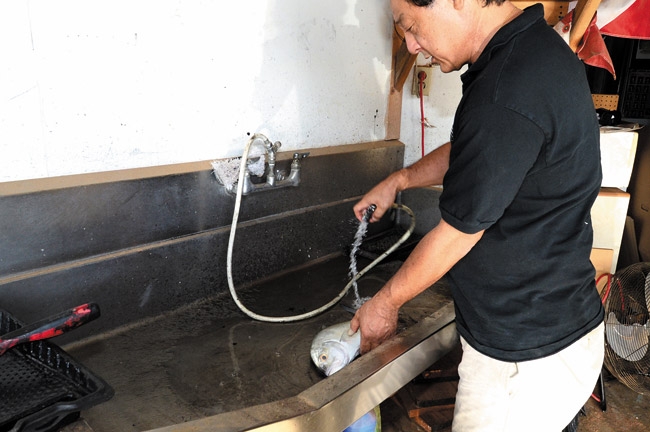Very Fishy Art
Naoki Hayashi went to college to study chemistry, but his love of the ocean, fishing and art led him to a career creating art based on fresh catches. And after each fish is reproduced on paper, it gets cooked and eaten
When the first catch of the day – a medium-sized white papio – arrives mid-morning at his studio in Kaneohe, Naoki Hayashi places it on a table and coats one side of it with non-toxic black acrylic paint. Moving quickly, seamlessly, Hayashi pats down the fish with an old T-shirt to remove some of the paint, then places a piece of shoji paper over the fish.
mw-feature-121813-gyotaku-1
He gently presses the paper onto the fish, and when he pulls it away, he reveals a perfect, detailed replica of the papio.
“This,” Hayashi says, holding up the paper, “is what is almost impossible with a brush and paint. This is what pressing can do – it picks up nature’s creations.”
The art of fish rubbing, also known as gyotaku, is a Japanese art form that is thought to have been created about 200 years ago in fishing villages. Gyotaku was designed as a way for fishermen to show people what they caught – the pre-camera equivalent of holding up the catch of the day for a photo.
“It is a keepsake of your story … All these guys have got stories attached to them,” he says, motioning to a large drawer stocked full of prints.
His studio is modest – it is tucked away in a strip mall and resembles, from the outside, an industrial warehouse rather than an art studio – but he sells about 1,000 prints a year to clients from all over the world through his business, Gyotaku by Naoki. His artwork can be found hanging everywhere, from local restaurants to Paris walls. Reyn Spooner also has created a few aloha shirts from his prints.
For Hayashi, the actual fish printing is just one part of the process. Catching the fish – and later eating the fish – is just as important. As impressive as his prints are, it is the story behind them that really matters. Each piece communicates the specifics of that fish – who caught it, how it was caught.
His studio is decorated with dozens of framed pieces, and hundreds of more prints are filed away in drawers: tako, big-eye tuna, mahi mahi. He races around his studio as he rattles off stories about each one, both his own fish and ones others have caught.
One was caught near the Blowhole, another group of moi was caught by a family near the Mokulua islands.
“This is from my Alaska trip,” he says, holding up a print of a huge halibut. “Just by looking at it, I can feel the crisp air in Juneau.”
Within minutes, the initial print is complete, and he washes the fish and freezes it. At the end of the day, he will fry it up for dinner. All of the fish that he prints are eaten, which, he says, is the point of fishing in the first place.
“If you destroy the quality of the fish, then you shouldn’t be doing this because it is not just an art subject, it is something that we go out to catch and eat,” he says, adding that he only works with edible fish.
As Hayashi tells it, the “hook was set early” (fishing metaphors pepper his speech, seemingly unconsciously) for him to become interested in gyotaku. Born in Japan, Hayashi was raised in Hilo by his grandparents. At age 11, he began fishing for kampachi with his grandparents and their friends in South Kona. One day, one of his grandpa’s fishing buddies dipped a kampachi in a bucket of paint that he happened to have in his truck. He then smacked it onto the young Hayashi’s shirt.
“He said to me, ‘Naoki, you have this fish forever now,'” he recalls.
In high school, he started creating prints of fish that he caught, presenting the images to family and friends for Christmases and birthdays. Soon his friends were asking him for prints of their fish.
When he went to college at Chapman University in southern California to study chemistry, his gyotaku practice took a backseat to books. After college, he returned to the Islands and worked as a scuba instructor. For the first time since his youth, he got to spend all day in the water, teaching in the morning and fishing in the afternoon. It was during that time that gyotaku came back to him.
Entirely self-taught, Hayashi learned everything he knows through trial and error. By the mid-1990s, he launched Gyotaku by Naoki. His prints start from about $200. His most expensive – a massive, multiframe series featuring a fish chasing bait – costs $10,000. In addition to framed prints, Hayashi also makes a range of products including T-shirts, calendars, lamps and more.
But one of his favorite parts of the job takes place outside the studio. He occasionally visits schools throughout the state to demonstrate gyotaku, and he even gives the kids a chance to try it out. He also incorporates a mini science lesson about fish anatomy and habitats. One of his most rewarding moments was when he ran into a former student at a NOAA conference.
“By then, she was college age, and she was involved with NOAA as an intern,” he recalls. “She told me, ‘Naoki, the day when you visited our class, I decided to do marine biology.'”
After a print dries, he will add color. With a few quick brush strokes, he colors bait in silver or adds green and blue to a mahi mahi. He rarely looks at reference photos before adding color to a piece.
“I grew up in the ocean, so I start thinking like fish. When I try to print them in a way to show how they chase bait, I am so used to seeing it, so I don’t need to look at any reference. I close my eyes and I imagine. I try to feel how it is to be in the water swimming with them.”
As he works, friends drop in and out. A fisherman friend was the one who had delivered the papio. Another fisherman stops by to chat, and the two reminisce about an epic catch during a Molokai trip.
There seems to be something about gyotaku that draws a crowd.
A few days later, gyotaku hobbyist Jeremy Willson sets up a makeshift work space in the game room of his home. He’s getting ready for what he calls a printing party.
“We get a bunch of people over, and people can just drop in. Some of the guys have brought back just some really, really neat fish,” says Willson, a fishery biologist.
By late afternoon, a few of his friends already have arrived, and Willson gets started on his first print of the day: a sickle pomfret.
In both style and approach, Willson’s work is markedly different from Hayashi’s. First, he works with an air-brush gun rather than a paint-brush. Once the paper comes off of the fish, Willson is done. And while Hayashi aims to re-create an ocean scene as realistically as possible, Willson pushes that concept in the other direction, often creating surreal images that could never occur in nature. One of his biggest points of pride is a Pacific fanfish that he has re-imagined with a red tail, a green body and a blue fin that hangs on his bedroom door.
Throughout the course of the night, Willson expects that up to a dozen people will show. Everything that the group creates tonight will be auctioned off at charity events for a group called My Ohana to help fund a performing arts center for low-income youths.
Back in Hayashi’s studio, he puts the final touches on a piece, coloring in the eyes of a mahi mahi and a few bait fish. This, he feels, really gives a piece life.
Hayashi relishes being able to help his clients preserve the memories of a fishing trip.
“It could show your boy’s first catch! That little fish, that symbol of that lucky day becomes priceless as the boy grows up to become Dad and then Granddad,” Hayashi says. “And then his grandkids are going to be looking and saying, ‘My grandpa caught this in 2013!’ You can’t put a price on that.”
For more information on Hayashi’s art, visit gyotaku.com. For more on Willson’s art, visit hawaiigyotaku.com.
Photos by Nathalie Walker
coconnor@midweek.com







